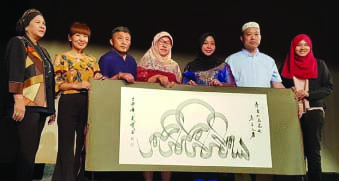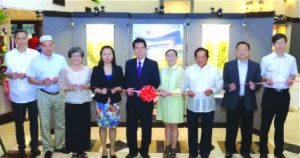
The historical account of Sulu’s Sultan Paduka Batara who visited China in 1417, the subsequent bond that grew between two ancient kingdoms, is an inspiring tale of enduring friendship that transcends borders and time.
For 600 years, China took care of the Sultan’s royal tomb in Dezhou, Shandong province where he died while on his way back to Sulu. He had gone to China to pay tribute to the imperial court of Ming Emperor Yong Le.
It is the only tomb of a foreign monarch in China with descendants still living in a village nearby to take care of it and to keep the Muslim faith alive.
On June 9 at the Bahay Tsinoy Museum of the Chinese in Philippine Life in Intramuros, Manila, guests gathered to commemorate the historic tribute mission of Sultan Paduka Batara.
Guests viewed a pictorial exhibit titled “600 Years of Enduring Friendship: Beyond borders, beyond time” and witnessed the launching of the book The Ties that Bind – the Saga of the Sultan of Sulu in China during the event.
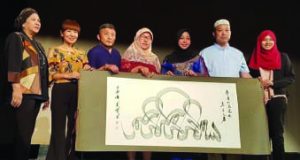
They got a glimpse of the complete story of the Sultan’s historic visit to Beijing, the subsequent illness and death in Shandong, his imperial burial and how his descendants preserved the tomb, the surrounding village and their Muslim faith.
Guests included officials from the Bureau of Culture in Shandong, representatives from the Sultanate of Sulu, dignitaries from the Department of Foreign Affairs and other government offices, various embassies, heads of Tsinoy organizations and Filipino academes, cultural organizations and nongovernment organizations have been invited to attend the event.
And of course, some descendants of the Sultan – Chinese and Filipino – were there as well.
It is truly remarkable that 600 years after the Sultan’s visit, the royal tomb, now a heritage park, stands as a visible sentinel and solid evidence of the strong and flourishing ties that bind the Philippines and China.

The occasion also marks the 42nd anniversary of the establishment of diplomatic relations with the People’s Republic of China and the 16th anniversary of Filipino-Chinese Friendship Day.
The hosts of the events, the Federation of Filipino-Chinese Associations and the Kaisa Para Sa Kaunlaran and its cultural arm, the Kaisa Heritage Foundation, have played significant roles in preserving and perpetuating this important historical vignette.
In 2005, the two organizations were responsible for bringing the Sultan’s descendants in China to their ancestral homeland in Jolo, Sulu after 588 years, two intervening dynasties, and a republic.
The descendants of Andulu the second son (now surnamed An) and Wenhalla the third son (now surnamed Wen) traveled from Shandong to Beijing to Xiamen to Manila to Zamboanga and finally to Jolo, fulfilling their ancestors’ wish that someday, they should visit their lao jia (老家 old home) across the seas.
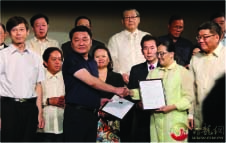
On their father’s death, Andulu and Wenhalla had stayed behind to look after his tomb, while their eldest brother Dumahan returned to succeed to the throne.
Joaquin Sy, KHF Vice President, started the program with the difficult task of acknowledging the important guests present.
Teresita Ang See then welcomed the guests on behalf of KHF president, special envoy Carlos Chan who was delayed in Beijing.
“The Philippines is known as the ‘Pearl of the Orient,’ ”said Chan in a prepared message. “Sulu’s Sultan Paduka Batara’s tribute mission to China in 1417, his royal tomb in Dezhou, Shandong, his 3,700 descendants living in China, are like a luminous pearl that illuminates 600 years of long-lasting continuous friendly relations and glorifies the Chinese and Filipino peoples’ enduring friendship.”
Chua Chi Hio, the president of FFCAP, emphasized that the event commemorates the historic visit of Sultan Paduka Batara and also provides an occasion to thank the Chinese government for taking care of the royal tomb for 600 years.
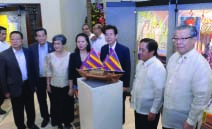
Undersecretary Ariel Y. Abadilla represented Secretary of Foreign Affairs Alan Peter Cayetano. He said that the Sultan’s voyage is but one of many examples of long-standing people-to-people ties between the Philippines and China that has endured through the centuries.
Abadilla also highlighted that “not only does the Sultan’s voyage represent international friendship, but it also shows that years before the Spaniards arrived on our shores, Filipinos were already skillful seafarers who navigated the great seas and oceans. It is a reminder that indeed, the sea flows in our veins. Let us keep close to our hearts our maritime legacy and rich history.”
He Qiang Qi, charges d’affaires of the Chinese Embassy, lauded the Kaisa and FFCAP for their efforts in preserving and promoting this story of friendship and at the same time, she hopes that the celebration does not end with this 600 years event but starts another journey of long lasting understanding and meaningful relations.
Yu Luhai, deputy director of Dezhou Bureau of Culture, Radio, Television, Press & Publication, emphasized the memorandum of agreement signed between the Dezhou Sulu Culture Museum and Bahay Tsinoy.
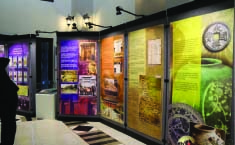
He said this “opens a new chapter in mutual research and exchanges in knowledge, expertise and information between our museums and establishes a new bridge in promoting friendly relations between our two countries.”
Ang See gave a Powerpoint presentation on the significance of the event. She emphasized that the Sultan’s journey happened 104 years before Magellan landed in the Philippines.
The voyage to China with an entourage of 340 people was a huge logistical challenge that showcased how advanced in civilization and technology our early Sulu ancestors were.
They were skilled boat builders and seafarers with extensive knowledge of currents, climate, astronomy and navigation. The Sulu Sultanate likewise had a sophisticated hierarchical political and economic system.
China gave great importance in preserving the tomb for 600 years as a symbol of enduring friendship that spanned two dynasties, the Republic of China, and now the People’s Republic.
The event closed with an exchange of gifts from Shandong and Sulu.
Two descendants from the An family – An Li Zhu (安立柱) and An Jing (安静) – and two from the Wen family –Wen Yong Ming (温永明) and Weng Fang (温芳) – gave gifts and recognition to the hosts of the event and to their distant cousin Princess Jacel Kiram, representing the Sultanate of Sulu, and likewise a descendant of Sultan Padukan Batara.
For her part, Kiram also gave recognition to Kaisa and FFCAP for their efforts in preserving the history and legacy of the Sultan of Sulu, truly a story of enduring friendship beyond borders and beyond time.
The 600th year celebration likewise unifies the contending factions in the Sulu Sultanate with their kamaganak (relatives) in far-away Dezhou, Shandong.
